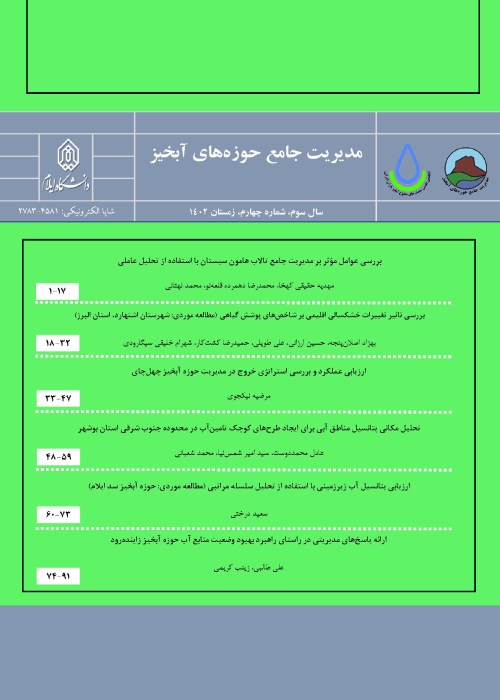Analysis of the Constituent Elements of the Desire of Watershed Residents to Participate in Watershed Management Projects (Case Study: Great Naein River Basin, Isfahan Province)
In order to achieve sustainable development and conservation of natural resources, it is necessary to promote the participation of individuals, especially users of natural resources. In fact, people's participation is of paramount importance in the implementation of environmental resource protection programs, and new trends in the global arena are based on strengthening the role of people in the protection of natural resources. Experts believe that the involvement of local individuals and groups in rural communities in watershed management projects can bring many benefits. It is believed that involving local people in the watershed management process can improve the technical and analytical skills of the users. In general, the success or failure of watershed management projects should be sought in the presence or absence of people. However, paying attention to the role of people in these projects and finding ways to encourage their participation is an inevitable necessity. Therefore, the general purpose of the present descriptive-correlational research is to prepare a causal model of the elements that influence the willingness of watershed residents to participate in watershed management projects of the Great Nain River Basin. Watersheds are influential and can promote the participation of watershed residents.
Naein Great River Basin with an area of about 130,000 hectares between 32 degrees; 45 minutes and 18 seconds to 33 degrees, 09 minutes and 20 seconds north latitude,52 degrees and 29 minutes and 18 seconds to 53 degrees, and 05 minutes and 41seconds is located on the east of the Greenwich meridian. The minimum height of this basin is 1552 meters and the maximum height is 3094 meters. This watershed is located in Naein city of Esfahan province in terms of national divisions and includes two villages of Koohestan and Baharestan and 41 inhabited villages with a population of about 2298 people. The statistical population studied in this study includes watershed residents living in Naein river basin of Isfahan province (N = 2298), among whom 476 people were selected as a statistical sample using Cochran's formula. due to the large size of the statistical population, random sampling method was used and information was collected. Finally, 476 questionnaires were collected and analyzed (performing stepwise regression, performing path analysis technique and preparing a causal model of the elements that influence the willingness of watershed residents to participate in watershed management projects).
The results of stepwise regression showed that social factors account for 69.1% of the willingness of watershed residents regardless of other variables. Also, social, economic, and communication factors as well as information resources and education item indicate a total of 74% of the changes in the willingness to participate in watershed management projects. The results obtained from the table of regression coefficients to determine the relative importance of variables and their effect on the willingness to participate showed that social factors have the largest share in the willingness of watershed participants to participate in watershed management projects and education item has the lowest share in their willingness to participate. Also, the causal model of the elements that influence the willingness of watershed residents to participate in watershed management projects showed that the factors mentioned above also have many indirect effects on the willingness of watershed residents. Therefore, according to the stepwise regression and the causal model prepared, planners and natural resource specialists should pay considerable attention to social, communication, and economic factors as well as information resources and education, For example, local councils can be used to foster the participation of local people in watershed management projects. Also, providing low-interest facilities and credits can greatly increase the motivation of local communities to participate in watershed management projects. Relevant organizations and the government can motivate local communities to participate in watershed management projects by creating jobs and improving the economic status of people. It can also be said that by promoting mass and social media, holding training classes, visiting other successful projects, etc., the level of participation in watershed management projects can be increased.
In general, the findings of this study indicate the great effects of three factors (economic, social and communication as well as information resources) and an individual item (education) on watershed participation, which was presented as a causal model of watershed participants' willingness to participate. Therefore, planners and natural resource specialists should pay considerable attention to these factors in order to increase the success of watershed management projects by encouraging more participation of watershed residents.
- حق عضویت دریافتی صرف حمایت از نشریات عضو و نگهداری، تکمیل و توسعه مگیران میشود.
- پرداخت حق اشتراک و دانلود مقالات اجازه بازنشر آن در سایر رسانههای چاپی و دیجیتال را به کاربر نمیدهد.



